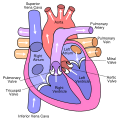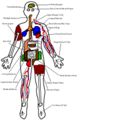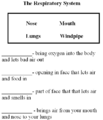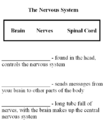Build a body
| Students @ Work - a student collaborative writing project. Help us by providing feedback on the Discussion page. |
| Instant wiki maker | Making handouts | Editing tips |
Contents
- 1 Student worthiness
- 2 Primary Biological Content Area Covered
- 3 Materials
- 4 Handouts
- 5 Description of Activity
- 6 Lesson Plan
- 7 Potential pitfalls
- 8 Literature connections
- 9 Art connections
- 10 Connections to educational standards
- 11 Next steps
- 12 Reflections
- 13 Citations and links
- 14 Common mistakes
Biology In Elementary Schools is a Saint Michael's College student project from a course that ran between 2007 and 2010 and fully described in this book chapter. The student-created resources have been preserved here for posterity. Link under 'toolbox' for printer-friendly versions of the exercises. Click on handouts to print full resolution versions. Please see Wikieducator's disclaimer, our safety statement, and the Creative Commons licensing in English and in legalese.
Student worthiness
Our activity was tried and extremely successful. The students had a great time building their body and walked away with a plethora of information.
Primary Biological Content Area Covered
- Learning the internal parts of the body
- Understanding their placement and functions
Materials
Materials Required for Teacher's Use
- The Magic School Bus: Inside the Human Body by Joanna Cole
Materials Required for Each Student Group:
| Respiratory System: | Circulatory System: | Digestive System: | Nervous System: | Urinary System: | Skeletal and Muscular Systems: |
| Blue ballons (not to be inflated) | Red yarn | Cutouts of Food | Yellow yarn | Plastic tops | Q-tips |
| Orange Construction Paper | Blue yarn | Plastic Bag | Sponge | Pink pipe cleaners | White Mesh |
| Small 3D plastic heart | Wire | Styrofoam circle | Red balloon | Pink construction paper | |
| Rope | Bungee cord | ||||
| Panty hose |
Materials for Individual Students:
- Roll of Paper
- Pencils
- Tape/Glue
- Markers
Handouts
Each group will recieve worksheets pertaining to the system that they will be working on. The worksheets contain each part of the body in that system with fill in the blank format with a work bank. Also, each student will receive a copy of a diagram of the human body with the parts labeled.
Description of Activity
We will be working with 6 groups of children and each group will represent a different system or area of the human body; respiratory, circulatory, digestive, skeletal, muscular, and nervous system. First, we will read, as a group, the portions of the book, The Magic School Bus: Inside the human body, which correlates to the group’s designated system. After we read, we will give each group various materials which will be representative of the human body parts belonging to their system. We will explain to the students which materials represent what i.e. the sponge represents the brain, the white mesh represents the rib cage, the wire represents the small intestines, and blue/red yarn represents veins/arteries. We will trace one of the team teachers on a large roll of white paper. Each group of students will use their materials and their knowledge from The Magic School Bus to make their own 3D model of their designated system which we will hopefully display at their school upon completion. After the students "build their body", they will fill out the worksheet provided, for their system, in order to strengthen their knowledge which they used throughout the activity.
Lesson Plan
Topic of the Lesson/Subject: The Human Body Grade/Course: 2nd Grade Science Time: 2 hours, 20 minutes each with 6 groups
DESIRED RESULTS:
Lesson Essential Question:
- What are the functions of human organs? And where are they located in the body?
Vermont Standards and/or GE's:
- S1-2:41 – Students demonstrate their understanding of Human Body Systems.
Learning Objectives:
- Students should demonstrate and understanding of organs and their functions.
- Students should demonstrate and understanding of organ systems and their placement in the human body.
Focusing Questions:
- How do organs work?
- What do organs do in the body?
- How do all the organs in the body work together?
ASSESSMENT EVIDENCE:
Criteria:
- Students will be assessed on their understanding of the systems in the human body, as well as the placement and functions of organs.
Product or Performance Task:
- Students will be assessed on their understanding of the systems in the human body by constructing a “mock-up” human body and complete a worksheet to see what they learned.
LEARNING PLAN:
Expectations:
- Students should demonstrate an understanding of the organs in the human body, students should understand the functions of the organs and their placement in the body.
Accommodations:
- Accommodations will be made for any and all students in order to reach all students educational needs.
Procedure:
- Introduction:
- This lesson will begin with The Magic School Bus: Inside the Human Body by Joanna Cole. This will be used to engage students as the learn about the functions of the organs and systems within the human body.
- Instruction:
- Each group of students will be responsible for one system of the human body. Students will review the functions and placement of the organ system using The Magic School Bus: Inside the Human Body by Joanna Cole. Then students will use the materials listed above to construct the organs in the system. Students will then place these organs on an outline of the human body. Each group will build upon one another to demonstrate the inter-connections of systems within the human body.
Closure and Connections:
- This lesson will end with students having constructed a human body complete with different organ systems. The constructed body should be displayed where students can see it, this way it may be used as a reference for students as well as a way to display the students’ artwork.
Potential pitfalls
Though this activity has not yet been taught, some potential pitfalls could be working with 6 groups of 9 students. Organization and time management will be key in the success of this activity. Also, young children may fight over who gets to do what. It is important to give each child an equal opportunity to participate and do his or her best to encourage sharing during the activity. Also, some of the supplies might be too heavy to have hanging on a wall. Perhaps we could experiment with different materials to make the "body" less heavy and stay on the wall easier.
Literature connections
We will be reading the students The Magic School Bus: Inside the human body which is an ideal read for children between the ages of 6-9. We are going to read the students the pages that connect to the system they will be working on. We hope that by reading the book to the children they will be able to understand the different systems of the human body better by seeing colorful illustrations accompanied by simple, accessible words. When the children “build their body” they will be forced to recall the information read to them and use it in order to place their materials in the correct areas of the body.
Cole, Joanna. Magic school bus inside the human body. New York: Scholastic, 1989. Print.
Art connections
A3-4:10 Students show skill development when CREATING art by… · Demonstrating techniques and processes in 2D work (e.g., drawing, painting, collage). · Using various art tools and materials for specific purposes. · Using elements of 2D and 3D design (e.g., 2D—mixing warm and cool colors; showing space through overlap, foreground, middle ground, and background; 3D— demonstrating form in papier mache, clay, fiber arts).
Connections to educational standards
S1-2:41- Students demonstrate their understanding of Human Body Systems
Next steps
Now that the students have explored all of the body systems and learned the basic functions, a good next step would be to look at a specific system in more detail. Maybe have the students that worked on each part tell the class a little about what they learned while doing it so that they can feel involved and share what they learned. This activity is a good introduction which allows the students to become excited about the human body and want to learn more! Maybe they could now look at the circulatory system and how the heart works considering that we stressed how important the heart is during the previous activity.
Reflections
The way we divided up who would teach which system of the body proved to be very efficient. The person responsible for each system read to the students and then showed them the materials which they would be using to "build a body". It was very helpful when we had the students raise their hands to volunteer to place different materials on the body diagram, there was less fighting and chaos.
We, as a group, were caught off guard by certain questions that the students posed. We assumed that second graders would not have learned about the Reproductive System, thus we chose to leave it out of our project. Surprisingly our second graders have learned some parts of the reproductive system and one student even asked, "Where would the baby come out if this was a girl?" Another unexpected thing happened.We used inflated balloons to represent the lungs and the students in the following groups mistook them for breasts. We decided it would be best to deflate the balloons at the end of our time at the Elementary School to clarify any confusion.
The students had many things to share with us about the human body. One girl informed us that her Daddy had broken his tailbone so we asked her to point to the body diagram and tell us where the tailbone is located. This was helpful because we did not refer to the tailbone in our lesson so the kids were able to learn something new from one of their classmates!
We were a little nervous while working with our first group of students, however our confidence grew with each group. It was obvious that the students were more engaged the more enthusiastic we were about the project. A "must do" for our project would absolutely be displaying enthusiasm for the activity, particularly while reading. The kids loved when we "did voices" and showed the pictures slowly. Showing the pictures while reading the text with enthusiasm helped the students to gain a better understanding of the Magic Schoolbus as well as excitement for their activity.
Citations and links
The original idea was taken from an Educator websiteand modified to fit our objectives.
Cole, Joanna. Magic school bus inside the human body. New York: Scholastic, 1989. Print.
Starr, C; Evers, C; Starr, L; 2007; Biology today and tomorrow; Thompson; Second Edition; Pages 364-375, 404-409, 415-419.
Common mistakes
None.














